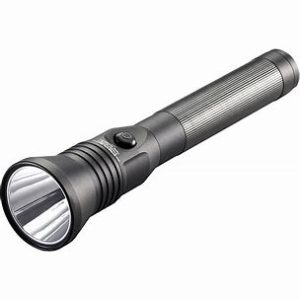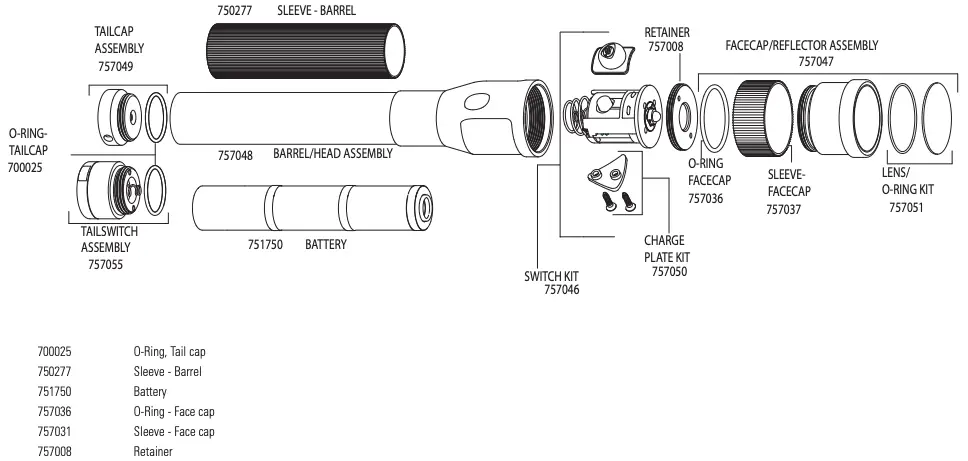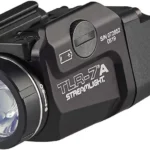
STREAMLIGHT Stinger® LED/ Stinger DS™ LED Operating Instructions

OPERATING INSTRUCTIONS FOR THE STREAMLIGHT STINGER® LED/Stinger DS
Thank you for selecting the Stinger® LED/Stinger DSTM LED, a new concept in portable lights. As with any fine tool, reasonable care and maintenance of this product will provide years of dependable service.
Please read this manual before using your Stinger® LED/Stinger DSTM LED. It includes important safety and operating instructions and should be saved Flashlight must be charged overnight before first use.
USING THE LIGHT
- The Stinger® LED features a head-mounted push button switch. The Stinger DSTM LED features a second independent tactical push button tailcap switch. For either switch:
- Depress the pushbutton switch once to turn the light on at full intensity.
- Press and hold the switch to cycle through brightness levels. Release at desired level.
- A quick double-click of the switch will activate the rapid flash function.
- A single press of the switch from any “on” mode will turn the flashlight off.
SAFETY
A. While eye damage from the Stinger® LED/Stinger DSTM LED is unlikely, it is a Class 2 LED product and YOU SHOULD NOT STARE INTO THE BEAM.
B. The Stinger® LED/Stinger DSTM LED is not approved for use in hazardous atmospheres.
C. SAVE THESE INSTRUCTIONS. This manual contains important safety, operating and maintenance information for your flashlight and charger.
D. CAUTION: To reduce risk of fire, electrical shock, or personal injury, do not attempt to use the charger to recharge any other product. Likewise, do not attempt to charge the Stinger® LED/Stinger DSTM LED with any other charger.
CAUTION: LED RADIATION – AVOID DIRECT EYE EXPOSURE – CLASS 2 LED PRODUCT
Maximum LED output < 60 mW per IEC 60825-1. Edition 1.2 2001 -08
E. Do not try to repair the unit or charger yourself. Take it to a qualified service facility or return it to the factory.
F. Use only battery #75175 (see parts list). The contact arrangement in the flashlight precludes the use of other batteries. Recycle worn out or damaged batteries properly. Do not attempt to incinerate the battery as it may explode in a fire. Handle the battery carefully and never allow it to short circuit.
G. Use of this product for other than a lighting device is not recommended. Streamlight specifically disclaims liability for other than recommended use.
CHARGING
Fully charge your flashlight before first use. Several charge/discharge cycles may be needed to achieve full battery capacity. The flashlight may be stored in the charger continuously when not in use.
To charge the flashlight, first turn it off and insert it into the charger. The triangular plate on the head fits into a mating recess in the charger. With the plate toward the charger, slip the barrel of the light between the charger arms and pull downward until it locks into place. The red LED on the charger housing must light to insure that the battery is being charged.
Keep the flashlight and charger contacts clean at all times. Poor contacts can cause charger malfunction. An abrasive pencil eraser works well to clean the contacts.
STEADY CHARGER
Full charge in 12 hours. Red LED remains on as long as flashlight is in the charger.
FAST CHARGER
The optional Fast Charger will charge a fully depleted battery within 2.5 hours. When the flashlight is inserted into the Fast Charger, the red LED on the charger will blink rapidly a few times and then light steadily, indicating the fast charge rate is being applied. When the charger senses that the battery has received a full charge, the charger switches to a lower “maintenance” rate and the red LED blinks. A secondary safety circuit will discontinue the fast rate after approximately 3.5 hours if for any reason the primary circuit fails to terminate the fast charge.
NOTE: OBSERVE THE RED LED:
- If the LED does not blink rapidly and continuously, indicating a full charge, within 2.75 hours check the contacts and the chargers power supply wiring. If no obvious problem is found, return the system to Streamlight for service.
- Proper function of the fast charge circuitry can be determined by inserting a flashlight into the charger for at least 5 minutes. Turn the flashlight “on” and the red LED should switch to blink mode within 5 minutes.
The Fast Charger is equipped with circuitry to prevent fast charging in temperature extremes (below 40? F and above 115? F). When temperature is within the acceptable range fast charging will begin.
PIGGYBACK® CHARGER
Available in fast and steady models (primary charger), Piggyback® chargers feature a steady-rate charger holder for a spare battery. The red Piggyback LED will glow indicating charge a long as the battery remains in the charger.
NOTE: When the spare battery is out of the Piggyback® charger, keep the yellow battery cap over the battery contacts to avoid shorting out the battery.
A yellow battery cap is included in accessory battery packs and with the extra battery included in Stinger PiggyBack models. Please retain this yellow battery cap and place over the battery contacts, when not in use, to avoid shorting the battery.
Before mounting a Streamlight charger in a vehicle, please read the following sections.
CHARGER MOUNTING
The charger should never be mounted against any heat sensitive surface.
Before drilling any holes, make sure there is room to insert and remove the flashlight.
Two (2) self-tapping #8 x 2″ screws are included to mount the charger. The correct size hole for these screws in sheet metal is 1/8.”
VEHICULAR CHARGING
A 12VDC power cord (#22051) is equipped with a cigarette plug and is available for mounting a Streamlight charger in a vehicle. The plug can be removed and the wires can be attached directly to a power source for a more permanent installation. (A two amp fuse must be used on the positive lead.)
IMPORTANT: Before making electrical connections in a vehicle, keep in mind that a shorted auto battery can easily start a fire. Make all connections with insulated lugs or other connectors intended for such use. Be sure that your installation is fused.
The striped power lead is positive and the unmarked lead is negative. When connecting the charger to a fuse block the striped, positive power lead goes to the connector that is dead when the vehicles fuse is removed. The charger body is electrically isolated from the charge circuit and allows positive ground installations. The charger is diode protected and if connected in reverse polarity simply won’t operate until connected properly.
Streamlight recommends connecting chargers to an unswitched source of power to ensure the flashlight is always fully charged. If the vehicle will not be driven for several days, the flashlight should be removed from the charger to avoid vehicle battery drain.
Charging the flashlight with a Steady Charger draws a constant .2 amperes from a vehicle.
The optional Fast Charger will draw between .5 and .7 amps for up to 2 1/2 hours during the fast charge period. During maintenance charge, current is pulsing and effectively draws .1 amps.
BATTERY REPLACEMENT
Simply unscrew the tailcap and slide the battery from the flashlight. Replace the battery inserting the contact end first and reattach the tailcap.
CARE AND USE OF NICKEL-CADMIUM BATTERIES
In order to obtain the maximum performance and life from nickel-cadmium batteries:
- Do not periodically “condition” or “exercise” your flashlight battery despite what you may have been told about nickel-cadmium “memory.” The actual existence of “memory” in a battery used under the conditions of flashlight service is extremely unlikely. Streamlight specifically discourages a regular cycle of deep discharging, which is not only unnecessary, but will greatly shorten battery life and could lead to a hazardous battery failure.
- Rarely there may be a small leakage of alkaline electrolyte from the safety vent on top of the cell. It appears as a powdery substance and can affect the integrity of the electrical contact. We recommend that your battery be periodically inspected and the contact area wiped clean. Use caution when handling a battery that has leaked. The electrolyte is a strong caustic and can burn or irritate the skin and eyes.
- Although the flashlight is designed to be left on charge continuously, there is an exception; if the surrounding temperature is below 10°F, continuous charging is not recommended.
